 Sega releases the arcade video game Carnival in the United States, developed by their subsidiary Gremlin Industries.
Sega releases the arcade video game Carnival in the United States, developed by their subsidiary Gremlin Industries. ![]()

 Sega releases the arcade video game Carnival in the United States, developed by their subsidiary Gremlin Industries.
Sega releases the arcade video game Carnival in the United States, developed by their subsidiary Gremlin Industries. ![]()
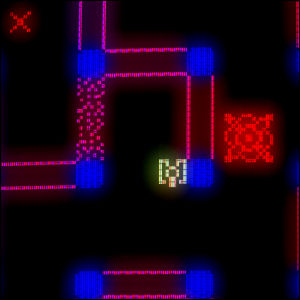 Sega releases the arcade game Pulsar in American arcades. The coin-op video game is a maze game pitting the player’s tank against enemy tanks and the structure of the maze itself.
Sega releases the arcade game Pulsar in American arcades. The coin-op video game is a maze game pitting the player’s tank against enemy tanks and the structure of the maze itself. ![]()
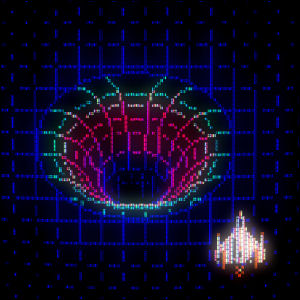 Sega releases the arcade game Space Odyssey in American arcades. With its depiction of Schwarzchild radius-style black holes scrolling under the player’s spaceship, this is among the first arcade video games with isometric 3-D graphics.
Sega releases the arcade game Space Odyssey in American arcades. With its depiction of Schwarzchild radius-style black holes scrolling under the player’s spaceship, this is among the first arcade video games with isometric 3-D graphics. ![]()
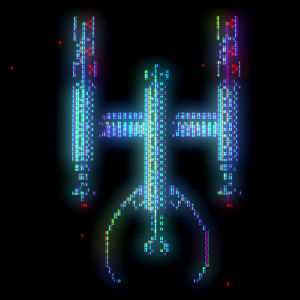 Sega introduces Astro Blaster to an arcade scene already awash in space shoot-’em-ups, but the game carves out a small niche for itself. Its greatest contribution, later on, may be in providing much of the inspiration for Activision’s home video game hit Megamania.
Sega introduces Astro Blaster to an arcade scene already awash in space shoot-’em-ups, but the game carves out a small niche for itself. Its greatest contribution, later on, may be in providing much of the inspiration for Activision’s home video game hit Megamania. ![]()
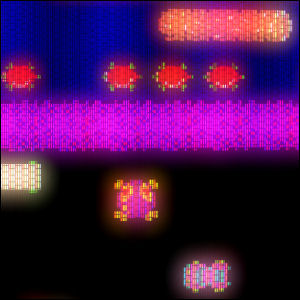 Created by Japanese video game manufacturer Konami (which has yet to establish a corporate foothold in North America), Frogger is introduced to the United States by Sega, and becomes an instant arcade hit whose cute graphics make it a natural for Pac-Man fans. In time, Frogger inspires a rock song, a cartoon, and numerous home video game cartridges.
Created by Japanese video game manufacturer Konami (which has yet to establish a corporate foothold in North America), Frogger is introduced to the United States by Sega, and becomes an instant arcade hit whose cute graphics make it a natural for Pac-Man fans. In time, Frogger inspires a rock song, a cartoon, and numerous home video game cartridges. ![]()
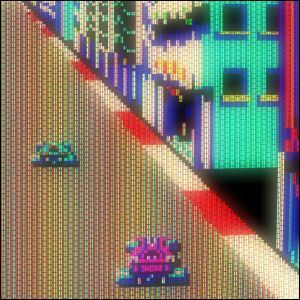 Sega raises the graphical bar for first-person driving games with the release, at year’s end, of the arcade game Turbo. Adding constantly-changing, scrolling scenery and a variety of other cars as obstacles, Turbo undoubtedly trips up many a video game racing veteran with pure eye candy.
Sega raises the graphical bar for first-person driving games with the release, at year’s end, of the arcade game Turbo. Adding constantly-changing, scrolling scenery and a variety of other cars as obstacles, Turbo undoubtedly trips up many a video game racing veteran with pure eye candy. ![]()
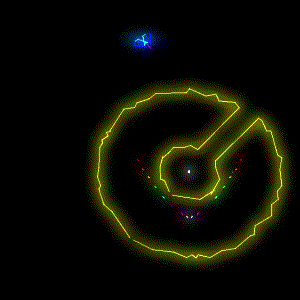 Sega/Gremlin releases the vector graphics arcade game Eliminator, in which one or two players team up (or go against each other) while trying to fire a shot down a narrow opening in a large, round, mobile space station with dangerous armament which is definitely not the Death Star. The two-player version is available as an upgright cabinet; a four-player cocktail table version is also made available.
Sega/Gremlin releases the vector graphics arcade game Eliminator, in which one or two players team up (or go against each other) while trying to fire a shot down a narrow opening in a large, round, mobile space station with dangerous armament which is definitely not the Death Star. The two-player version is available as an upgright cabinet; a four-player cocktail table version is also made available. ![]()
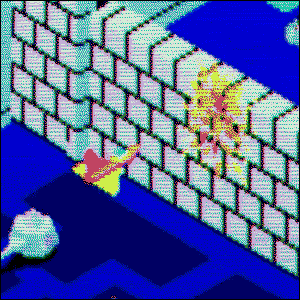 Sega introduces the cult classic arcade game Zaxxon, significantly raising the bar for arcade graphics with its three-quarter isometric 3-D view (and making it nearly impossible to translate faithfully to home video game consoles of the era). Though this new perspective doesn’t make Zaxxon easy to play, it becomes one of the first video games that players line up just to look at.
Sega introduces the cult classic arcade game Zaxxon, significantly raising the bar for arcade graphics with its three-quarter isometric 3-D view (and making it nearly impossible to translate faithfully to home video game consoles of the era). Though this new perspective doesn’t make Zaxxon easy to play, it becomes one of the first video games that players line up just to look at. ![]()
 Sega releases the arcade game Tac/Scan in American arcades. The vector graphics coin-op switches rapidly between a traditional overhead view and a first-person view several times during each game, including a sequence in which players are asked to navigate a dizzying warp tunnel.
Sega releases the arcade game Tac/Scan in American arcades. The vector graphics coin-op switches rapidly between a traditional overhead view and a first-person view several times during each game, including a sequence in which players are asked to navigate a dizzying warp tunnel. ![]()
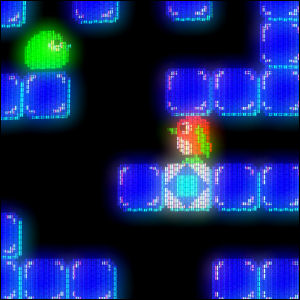 Sega releases the arcade game Pengo in American arcades. The game goes through several iterations and revisions related to the legality of music use.
Sega releases the arcade game Pengo in American arcades. The game goes through several iterations and revisions related to the legality of music use. ![]()
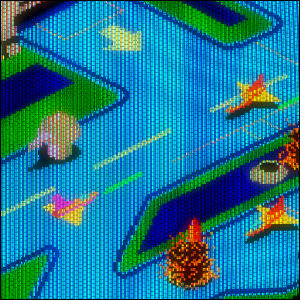 Desperately trying to keep its coin-op games fresh, Sega releases the arcade game conversion kit Super Zaxxon. The kit updates Zaxxon machines with new graphics and levels, giving arcade operators the chance to put a “new” machine in circulation without purchasing an entire new cabinet.
Desperately trying to keep its coin-op games fresh, Sega releases the arcade game conversion kit Super Zaxxon. The kit updates Zaxxon machines with new graphics and levels, giving arcade operators the chance to put a “new” machine in circulation without purchasing an entire new cabinet. ![]()
 Sega releases the arcade game Buck Rogers: Planet Of Zoom in American arcades. Completely unrelated to the recent television series, the graphically impressive game is designed to be the first in a series, but no further games in the projected series ever materialize.
Sega releases the arcade game Buck Rogers: Planet Of Zoom in American arcades. Completely unrelated to the recent television series, the graphically impressive game is designed to be the first in a series, but no further games in the projected series ever materialize. ![]()
![]()
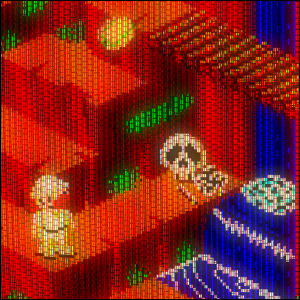 Sega releases the arcade game Congo Bongo in American arcades. Using the same graphical approach as Zaxxon, Congo Bongo is a 3-D take on the oddly familiar theme of a man climbing a structure to capture an ape.
Sega releases the arcade game Congo Bongo in American arcades. Using the same graphical approach as Zaxxon, Congo Bongo is a 3-D take on the oddly familiar theme of a man climbing a structure to capture an ape. ![]()
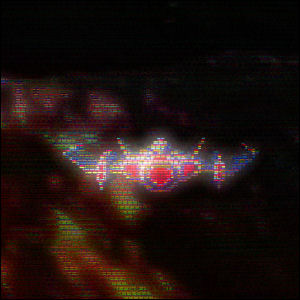 Segaa releases the arcade game Astron Belt in American arcades. The first game to go into development specifically as a laser videodisc game, Astron Belt is a minor hit but it overshadowed by the Disney-esque visuals of another laserdisc coin-op, Dragon’s Lair.
Segaa releases the arcade game Astron Belt in American arcades. The first game to go into development specifically as a laser videodisc game, Astron Belt is a minor hit but it overshadowed by the Disney-esque visuals of another laserdisc coin-op, Dragon’s Lair. ![]()
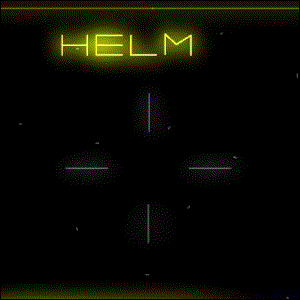 Segaa releases the arcade game Star Trek: Strategic Operations Simulator in American arcades. The vector graphics coin-op, simulating the “tactical views” seen on the Enterprise in the first two Star Trek movies, is the first officially licensed Star Trek video game. It also reflects some corporate synergy: Sega was, at the time, also owned by Paramount Pictures parent company Gulf + Western.
Segaa releases the arcade game Star Trek: Strategic Operations Simulator in American arcades. The vector graphics coin-op, simulating the “tactical views” seen on the Enterprise in the first two Star Trek movies, is the first officially licensed Star Trek video game. It also reflects some corporate synergy: Sega was, at the time, also owned by Paramount Pictures parent company Gulf + Western. ![]()
![]()